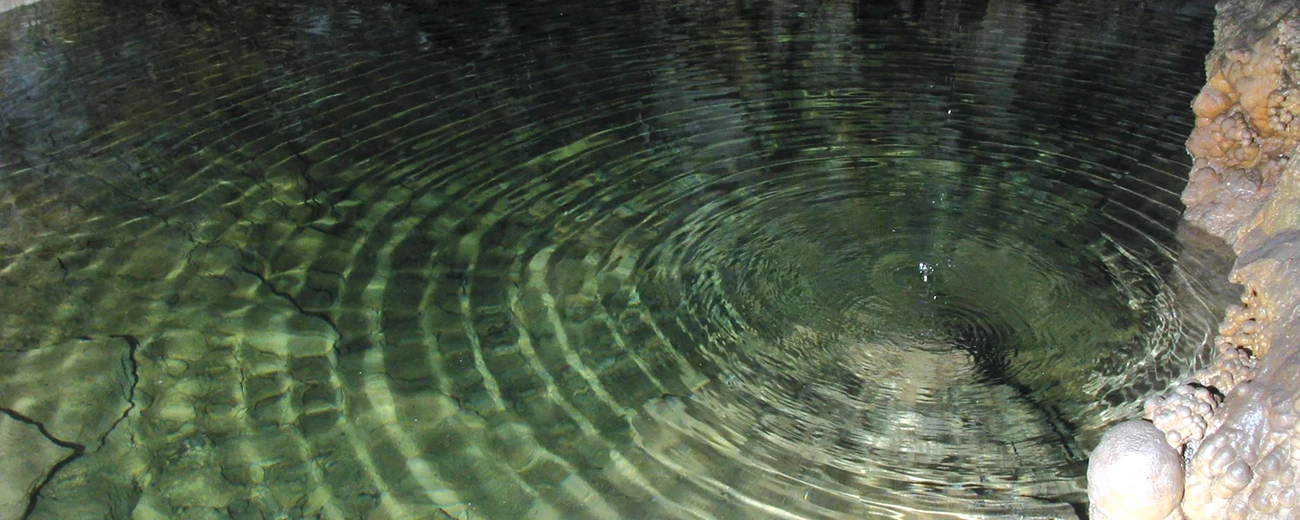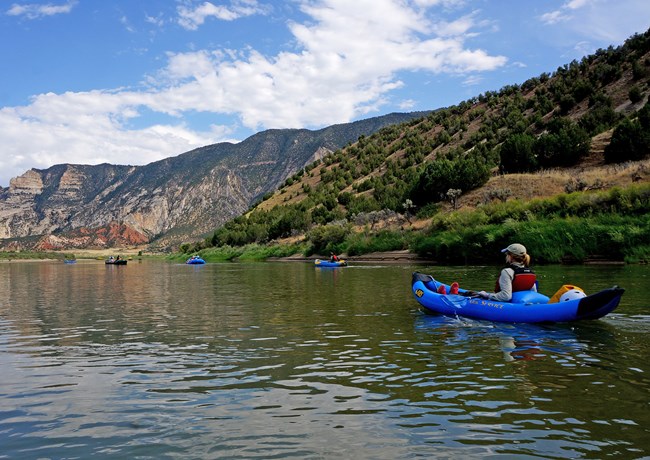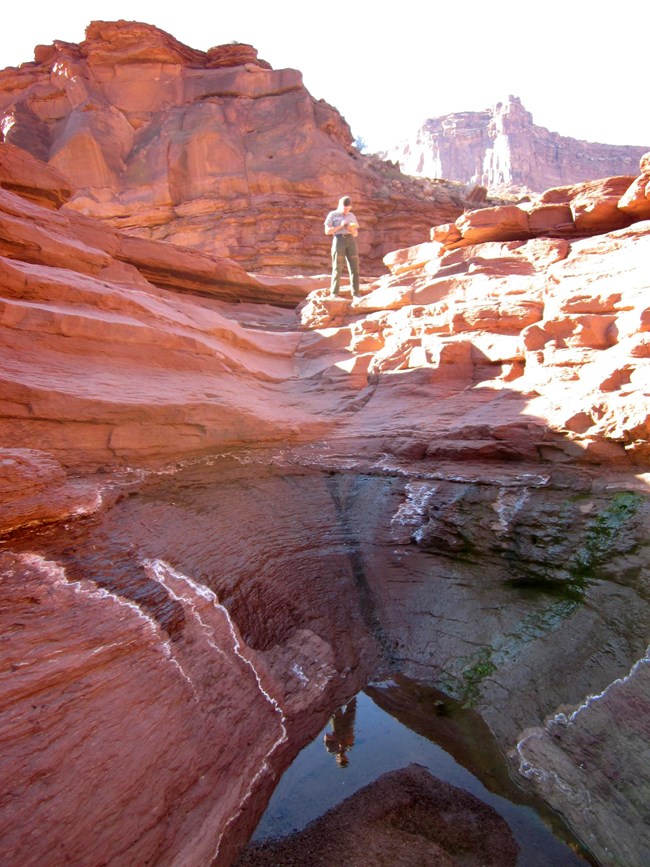Last updated: March 14, 2022
Article
Contaminants of Emerging Concern in Northern Colorado Plateau Park Waters

Background
For many years, it’s been apparent that the things we use in everyday life are ending up in the environment. Agricultural pesticides, antibiotics, household microplastics, and even sunscreen and insect repellent are all being found in streams and rivers. It’s not too surprising to find those kinds of contaminants near cities or farms—but would you expect to find them in a national park?
Scientists from the National Park Service, Environmental Protection Agency, and U.S. Geological Survey wanted to know. For several years, they sampled waters across the National Park System—everywhere from urban settings to predominately natural landscapes, like the Colorado Plateau.
The samples were tested for contaminants of emerging concern (CECs). CECs are substances that are largely unregulated in the United States but are now commonly found in surface waters. The study analyzed three kinds of CECs: pesticides, pharmaceuticals and personal care products (PPCPs), and wastewater indicators (WWIs).

What We Found
From 2012 to 2016, hundreds of samples were collected at 21 sites in eight national parks of the Northern Colorado Plateau Network (NCPN): Arches National Park, Bryce Canyon National Park, Canyonlands National Park, Capitol Reef National Park, Dinosaur National Monument, Hovenweep National Monument, Timpanogos Cave National Monument, and Zion National Park.
The results showed that even in isolated areas, CECs are not uncommon. Waste is getting into natural aquatic systems where it might not be expected.
At most NCPN sites, at least one PPCP and/or WWI was detected on over half of all sampling visits. However, they were generally found less often, and at lower concentrations, than in urban or agricultural watersheds. The contaminants most frequently detected were DEET, caffeine, household flame retardants, bisphenol A (BPA), fecal indicators, and polycyclic aromatic hydrocarbons (byproducts of biofuel combustion from sources like vehicle exhaust, power plants, and wildfires).
At a few sites, the same contaminants showed up over and over (in 50% or more of samples taken). These are referred to here as “chronic.”
- Certain pharmaceuticals were chronic at sites on major rivers with upstream communities and wastewater-treatment discharge (see table). The Colorado River at Potash site, about 15 miles (24 km) downstream from the Moab, Utah, wastewater treatment plant, had the highest number of chronic CECs of any site in the study.
- Personal care products were chronic at two cave locations in Timpanogos Cave NM (see table). Located high in a forested watershed, these two sites receive about 100,000 visitors per year. Consistent visitation, paired with slow atmospheric and cave-water turnover, may contribute to this contamination. (In contrast, samples from The Narrows, at Zion NP, had no chronic CECs, despite thousands of visitors wading in the river each day during the recreation season.)
- The pesticide, triclopyr, was chronic in and near Canyonlands and Arches national parks (see table). This may be associated with the use of a triclopyr-based herbicide to control tamarisk in these parks.
- Fecal indicators were chronic at streams and isolated springs at four parks (see table).

What it Means—and What You Can Do
The amounts of contaminants found in NCPN parks were generally very low. When it does occur, chronic contamination seems most likely if there is a wastewater treatment plant upstream, or in situations with low or stagnant flow, where contaminants can’t easily be washed out of the system.
At current levels, the CECs detected aren’t likely to affect vertebrates, such as fish or frogs, or be a public health risk. That’s good news for park managers and visitors. But some type of contaminants were found at most sites—even isolated sites—on at least half of sampling visits. Wherever we go, we take our contaminants with us.
Every park visitor can make a difference in the quality of park waters on the Colorado Plateau. Because contaminants can come not only from human waste, but also from skin and clothing, there are two important ways visitors can help keep park waters healthy and pristine:
- Whenever possible, answer nature’s call (i.e., deposit human waste, whether liquid or solid) at least 200 feet from water sources, and
- Avoid making physical contact with low-flow springs and pools.
| CEC | Description/use | Potential source | Site | Park (in/near) | Site type |
|---|---|---|---|---|---|
| Pharmaceuticals | Various types | Human | Colorado River at Potash | Canyonlands NP | Major river |
| Pharmaceuticals | Various types | Human | Green River at Mineral Bottom | Canyonlands NP | Major river |
| Pharmaceuticals | Various types | Human | Yampa River at Deerlodge | Dinosaur NM | Major river |
| Caffeine (dissolved) | Common stimulant | Human | Hansen Cave | Timpanogos Cave NM | Cave pool |
| DEET | Insect repellent | Human | Middle Cave | Timpanogos Cave NM | Cave pool |
| Galaxolide | Synthetic fragrance in household products | Human | Middle Cave | Timpanogos Cave NM | Cave pool |
| Triclopyr | Pesticide | Human | Colorado River at Potash | Canyonlands NP | Major river |
| Triclopyr | Pesticide | Human | Lower Courthouse | Arches NP | Isolated spring |
| p-cresol | Colorless solid used in the production of other chemicals | Human/Natural | Upper Courthouse | Arches NP | Isolated spring |
| p-cresol | Colorless solid used in the production of other chemicals | Human/Natural | Green River near Jensen, UT | Dinosaur NM | Major river |
| indole | Fecal indicator | Human/Natural | Sleepy Hollow Spring | Arches NP | Isolated spring |
| indole | Fecal indicator | Human/Natural | Sulphur Creek | Capitol Reef NP | Stream |
| indole | Fecal indicator | Human/Natural | Green River near Jensen, UT | Dinosaur NM | Major river |
| indole | Fecal indicator | Human/Natural | The Grotto | Zion NP | Isolated spring |
| indole | Fecal indicator | Human/Natural | North Creek | Zion NP | Stream |
Information presented here was summarized from Weissinger, R. H., B. R. Blackwell, K. Keteles, W. A. Battaglin, and P. M. Bradley. 2018. Bioactive contaminants of emerging concern in national park waters of the northern Colorado Plateau, USA. Science of the Total Environment 636:910–918.
Tags
- arches national park
- bryce canyon national park
- canyonlands national park
- capitol reef national park
- dinosaur national monument
- hovenweep national monument
- timpanogos cave national monument
- zion national park
- ncpn
- northern colorado plateau network
- monitoring
- contaminants
- water quality
- northern colorado plateau
- arches national park
- bryce canyon national park
- canyonlands national park
- capitol reef national park
- dinosaur national monument
- hovenweep national monument
- timpanogos cave
- zion national park
- green river
- yampa river
- colorado river
- cave water
- courthouse wash
- water
- national parks
- water monitoring
- water pollution
- water quality monitoring
- water resources
- water testing
- rivers
- river management
